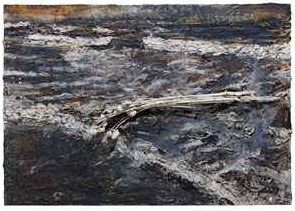Anselm Kiefer (b. 1945), Aphrodite
Anselm Kiefer (b. 1945), Aphrodite. Photo Christie's Image Ltd 2012
titled in Greek 'Aphrodite' (upper right); oil, emulsion, shellac, resin, plaster, wire and sunflowers on canvas; 75 3/8 x 110 1/8in. (191.5 x 280cm.). Executed in 2004. Estimate £450,000 - £650,000. Price Realized £529,250
Provenance: Heiner Bastian Fine Arts, Berlin.
Acquired from the above by the present owner in 2008.
Notes: 'I can only make my feelings, thoughts and will in the paintings. I make them as precise as I can and then after that you decide what the pictures are and what I am' (A. Kiefer, quoted in Anselm Kiefer für Chlebnikov, exh. cat., White Cube, London 2005, p. 22).
A vast canvas depicting a swirling maelstrom of turbulent, wrathful sea, adorned with a bundle of ethereal white sunflowers, Aphrodite offers richly nuanced exploration of the themes of history, myth and poetry that have characterised much of Anselm Kiefer's oeuvre. Executed in 2004, Aphrodite is closely related to the series of dramatic seascapes entitled Velimir Chlebnikov and the Sea exhibited in a pavilion specially designed by the artist at the Aldrich Contemporary Art Museum in 2006. Chlebnikov, whom the paintings were dedicated to, was a Futurist poet and mystical theorist whose esoteric ideas included the notion that climactic naval battles would occur every 317 years, its consequences of paramount cosmic significance for the course of human affairs.
Aphrodite was inspired by the eponymous Greek goddess. More commonly known for her other role as goddess of love, Aphrodite was also a sea goddess, a war deity and a patron of sailors. Kiefer has inscribed her name in white paint in Greek on the top right corner of the painting, whilst the foam and dark turgid water offers an allusion to her birth from the foam of the sea. Aphrodite's immensely textured painterly surface is a synthesis of the Romantic tradition, recalling the seascapes of artist's such as Caspar David Friedrich, and Abstract Expressionist painting's gestural approach to the sublime.
Drawing on the theme of war throughout time via ancient mythology and avant-garde poetry, Kiefer navigates between the difficult terrains of the necessity of remembrance and the possibility of transcendence. Chlebnikov, like Kiefer, rejected the idea of history and time as a linear, teleological process. In Aphrodite, time relates as much to the myth of the past as it foretells of the future: the overcast horizon at one with the turgid, restless sea, could be interpreted as the aftermath of a cataclysm, the healing of history with time, and the rebirth after the destruction of war, or indeed, it could be perceived as the forewarning of an imminent apocalyptic warfare. This ambiguity of interpretation is enhanced by the presence of the enigmatic white sunflowers, which could be read as the death of peace, or an ode to a new beginning and a remembrance to the fallen.
Kiefer is engaged in a relentless interweaving and reworking of themes that often intersect with one another, finding new articulation in different media and objects. His works are resistant to single interpretations, instead facilitating patterns of associations. Indeed, as the artist himself has said, 'I can only make my feelings, thoughts and will in the paintings. I make them as precise as I can and then after that you decide what the pictures are and what I am' (A. Kiefer, quoted in Anselm Kiefer für Chlebnikov, exh. cat., White Cube, London 2005, p. 22).
Christie's. Post War and Contemporary Art Evening Auction. 11 October 2012. London, King Street

/https%3A%2F%2Fprofilepics.canalblog.com%2Fprofilepics%2F1%2F0%2F100183.jpg)
/https%3A%2F%2Fstorage.canalblog.com%2F03%2F02%2F119589%2F96711876_o.jpg)
/https%3A%2F%2Fstorage.canalblog.com%2F11%2F31%2F119589%2F94773502_o.jpg)
/https%3A%2F%2Fstorage.canalblog.com%2F20%2F83%2F119589%2F94772815_o.jpg)
/https%3A%2F%2Fstorage.canalblog.com%2F26%2F72%2F119589%2F75604929_o.jpg)
/https%3A%2F%2Fstorage.canalblog.com%2F59%2F60%2F119589%2F26458628_o.jpg)



/http%3A%2F%2Fstorage.canalblog.com%2F84%2F57%2F119589%2F128729666_o.jpg)
/http%3A%2F%2Fstorage.canalblog.com%2F14%2F07%2F119589%2F126409285_o.jpg)
/http%3A%2F%2Fstorage.canalblog.com%2F19%2F32%2F119589%2F121087755_o.jpg)
/http%3A%2F%2Fstorage.canalblog.com%2F59%2F26%2F119589%2F118154956_o.jpg)